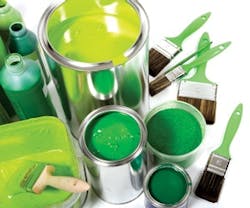Regardless if the wall you’re painting will be the color green, the coating you select should be. Paint ingredients have impacts on environmental and social responsibility that reach beyond just unpleasant odors and volatile organic compounds (VOCs).
When evaluating the right paint for your application, consider how eco-friendly the paint is and how well it will perform.
Sustainability
Paints can be made out of recycled, natural, or bio-based content. Although you won’t find an ingredients label on most paint cans, companies are starting to divulge more information about their formulas because it impacts corporate social responsibility.
Kelly-Moore Paints pioneered the concept of recycling paint about 15 years ago. Manufacturers Dunn-Edwards and MetroPaint also recycle their paints.
“We make it known to our contractors and accounts that we are environmentally friendly and recycle. If they bring back their abundance of product, we remanufacture it,” says Dan Saldivar, national accounts manager for Kelly-Moore.
Their eCoat is made of 50% recycled paint and 50% new stock. It retails for about $18 per gallon, while their two zero-VOC lines are $30 and $40 per gallon. Kelly-Moore’s eco-friendly lines have earned several certifications, including Green Wise, Indoor Advantage Gold, and Master Painters Institute’s Green Performance Standard.
Sherwin-Williams developed a sustainable product with a different approach.
“We are always looking for ways to use alternative raw materials versus conventional,” explains Steve Revnew, vice president of product development for the manufacturer. “That adds to the environmental responsibility of the formulation.”
The Emerald line from Sherwin-Williams utilizes soybean and sunflower oils, and the resin contains recycled plastic bottles, Revnew adds. It is GREENGUARD Indoor Air Quality certified.
Typically, colorants are one of the components of paint that contributed VOCs. Some manufacturers are using new technology to tint paints without adding VOCs, including Benjamin Moore and Co. and Sherwin-Williams.
While some paints include bio-based materials, others are 100% natural. Unearthed Paints produces coatings, plaster, and finishes from clay, chalk, lime, and Italian marble. Vegetable casein protein acts as a binding agent, similar to milk paints but without the odors and environmental concerns.
They are colored with mineral pigments including ochers, sienna, umbers, ultramarines, and spinels. Though colors are limited to those found in earth, rocks, and volcanic gemstones, Unearthed Paints come in up to 35 colors, each with three different shades.
“The pigments come from locations around the world that have colorful earth,” explains Unearthed's owner Jessica Pfohl. “There is a depth, richness, and natural beauty you wouldn’t find in conventional paint.”
Unearthed products are biodegradable, non-toxic, and odorless. They have no added chemicals and are naturally VOC-free. Öko-Test – a consumer magazine in Germany, where Unearthed is manufactured – has given its highest rating to a number of Unearthed products.
Performance and Longevity
Although sustainability is a relevant concern, eco-friendly products still should be durable and long-lasting, otherwise they don’t make sense. Failures are environmental and financial burdens.
Some eco-friendly paints have anti-microbial properties and are resistant to scrubbing, staining, and burnishing, just like conventional paints. They also maintain stable viscosity and thickness.
Previous zero-VOC colorants caused poor drying and water sensitivity that led to blushing and blistering, Saldivar explains, but most eco-friendly lines have the same performance and service life as conventional coatings.
“The solvents used with higher VOCs aren’t as troublesome as far as application,” he adds. “Low-VOC paint used to be harder to apply because the solvents that allow it to flow out and spread weren’t in it.”
The right natural paint can also be durable. Clay has its own binding properties, and when combined with casein, the result is very strong, Pfohl explains. Unearthed Lime Paint essentially becomes a layer of limestone as it hardens, she adds.
Both sustainability and performance should guide your decision regardless of which brand you use.
“Low-VOC paints used to be a way to sell your building,” Pfohl explains. “But using paint like this is a way to show you’re taking the next step and doing the right thing.”
Chris Curtland ([email protected]) is assistant editor of BUILDINGS.
